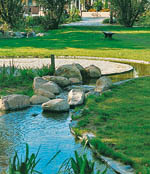Designing gardens with water
Tim Richardson gets to grips with the challenges of water features in gardening


Designing with water has always been a difficult business, from both a practical and a theoretical point of view. ‘Capability’ Brown would not have had the success he had were it not for his confidence in creating, enlarging or reshaping bodies of water. Among his watery triumphs, there is Blenheim, of course, but how about Trentham, in Staffordshire?
That garden’s Victorian Italianate terraced parterres have recently been revamped courtesy of Tom Stuart-Smith, in league with the Dutch ‘New Perennials’ maestro Piet Oudolf but what really took my breath away, when I visited the site before restoration work commenced, was the massive lake that Brown engineered in the mid 18th century.
Trentham may be just a couple of miles from the centre of benighted Stoke-on-Trent and also undermined (literally) by the National Coal Board’s former works, but this mammoth expanse of smooth water framed by mature trees is, for me, the most authentically Claudean vista in England.
It took hundreds of men and considerable engineering nous to begin such projects, yet they often went awry. Garden history is littered with exclamations of dismay and despair from garden owners driven half-mad by the vagaries of water. Here is William Shenstone of The Leasowes at Halesowen bemoaning his lot in 1760: his watercourse excavations had ‘confin’d me, employ’s my servants, and enslav’d my horses all this year’.
A designer or owner who could deal effectively with water was a valuable commodity then as now. Shenstone’s contemporary Copleston Warre Bampfylde of Hestercombe in Somerset made a magnificent waterfall in his own landscape garden, which has been superbly restored and can be enjoyed today, and he was also in demand by other landowners, such as his friend and neighbour Henry Hoare at Stourhead (where Bampfylde made the cascade) and even the king, at Virginia Water. No wonder Shenstone was jealous of him.
The situation hasn’t really changed. All designers like to intimate that they’re at home with water, but anything ambitious tends to get hived off to specialists. Herbert Dreiseitl in Germany has the most significant international reputation in this sphere. At the start of his career, three decades ago, he decided to specialise in water design, and he has been quietly working away ever since, and publishing the odd book (in German).
One of Mr Dreiseitl’s secret weapons is his good relationship with the scientists at the well-named Institute of Liquid Science, based near his office on the shores of Lake Constance. It means he’s always up to speed with the latest ideas about the movement, inner structure and rhythmical movement of water, and that has led to innovations such as his design for the pools in a square in the town of Hannoversch Münden, where the urban soundscape is converted via microphones into underwater booms that ruffle the surface of the water, which are themselves reflected back as light onto surrounding buildings.
Exquisite houses, the beauty of Nature, and how to get the most from your life, straight to your inbox.
The shapes of Mr Dreiseitl’s watercourses tend towards simplicity; he says he’s essentially working with surface texture, as well as humidity, mist and even the scent of water.
Sophisticated water ideas such as his haven’t been adopted everywhere witness the aesthetic disaster that is the bombastic main cascade at Alnwick but they have trickled down (forgive me) into the mainstream, as at the unfairly maligned Diana Memorial Fountain in Kensington Gardens. Now that the trees are growing up, that feature is at last becoming a glade episode, as it was always intended to be. It cleverly captures the vicissitudes of the late princess’s life and personality by means of a variety of watery moods, created principally by the carefully engineered texture of the stone watercourse.
Mr Dreiseitl is scornful of the ubiquitous vertical jet we still see appearing in so many new public squares, in the guise of grids of rhythmically spurting fountains. Admittedly, children love to dance through these, but as a feature, it is now rather overdone, having ‘premiered’ at the Parc André Citroën in Paris in the 1980s. Perhaps in our gardens, squares and parks, we’ll soon start to see more ‘liquid narratives’ of the kind pioneered by Mr Dreiseitl?
Country Life is unlike any other magazine: the only glossy weekly on the newsstand and the only magazine that has been guest-edited by His Majesty The King not once, but twice. It is a celebration of modern rural life and all its diverse joys and pleasures — that was first published in Queen Victoria's Diamond Jubilee year. Our eclectic mixture of witty and informative content — from the most up-to-date property news and commentary and a coveted glimpse inside some of the UK's best houses and gardens, to gardening, the arts and interior design, written by experts in their field — still cannot be found in print or online, anywhere else.
